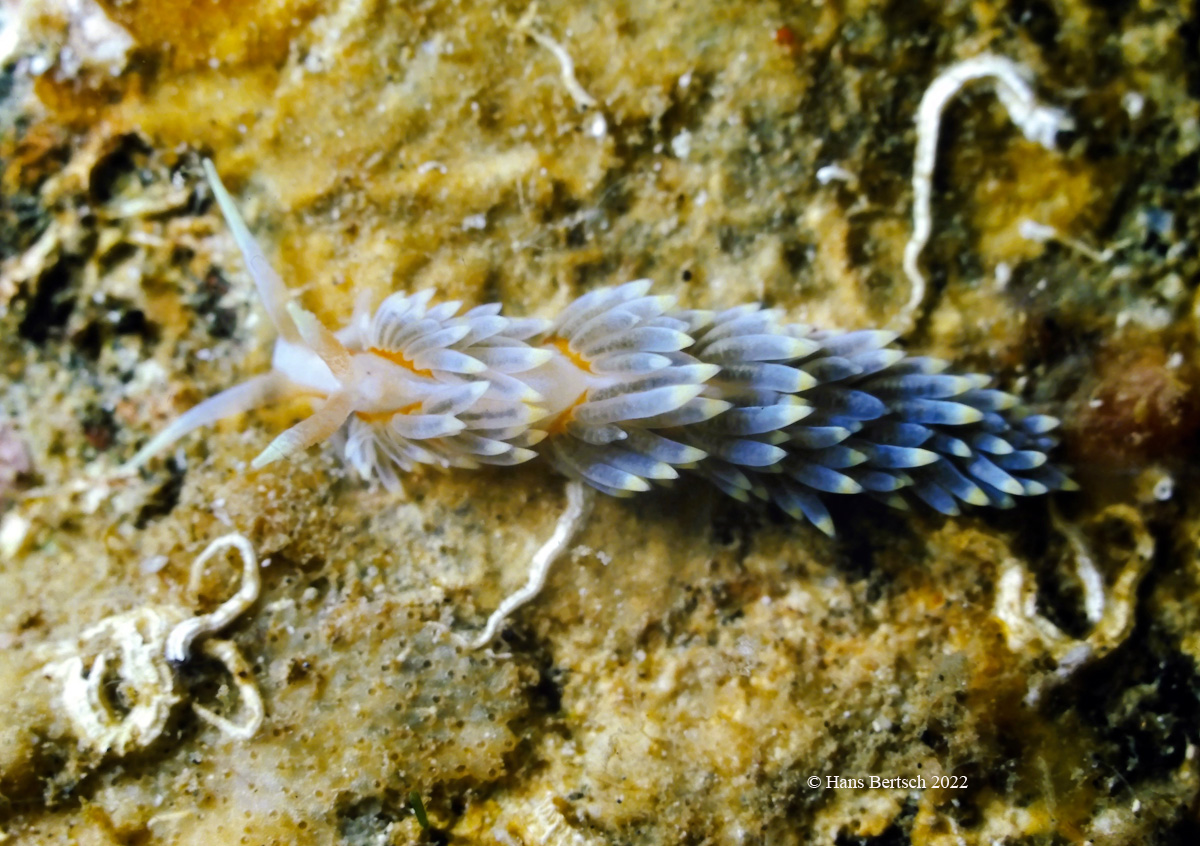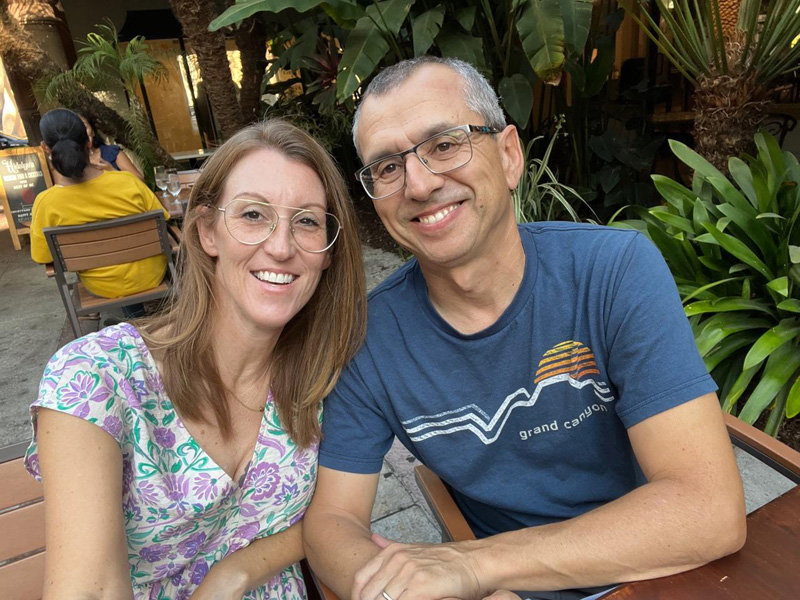 |
Berghia stephanieae
Point of Fort Jeudy, Grenada. 14 feet deep, 24 August 1986.
Photo by Hans Bertsch
Berghia stephanieae (Valdés, 2005)
A pretty little aeolid, with an elongate body, wider anteriorly. Living animals are translucent gray with opaque white pigment covering the dorsum; on the head the white pigment forms a triangular patch that ends behind the eyespots. White pigment on the distal half of the rhinophores and oral tentacles. Jaws are visible as two light brown to orangish patches on both sides of the head.
Triangular and elongate foot corners. Oral tentacles about twice as long as the rhinophores. Rhinophores have about 6-10 inconspicuous lamellae, occurring only on the distal half and surrounding the entire surface.
Cerata arranged in straight rows, divided into groups separated by narrow gaps. The genital aperture occurs ventrally to the second and third rows of the first group of cerata. Cardiac region between the first and second groups. Anus cleioproctic, opens beneath the third group of cerata, and the nephroproct is situated anterior to the anus.
Diaulic reproductive, with a long and slightly curved ampulla.
Radular formula 22 x 0.1.0. The pectinate radular teeth have a concave base with a reduced central cusp. There are 20-25 long, pointed denticles on each side of the cusp. Jaws oval, with several irregular denticles on the masticatory border.
Two specimens were found at Point of Fort Jeudy, Grenada, while scuba diving in 14 feet of water, on 24 August 1986. The pair measured 13 and 22 mm in length each. Previously, this species was only known from its Florida Keys type locality (Valdés et al., 2006). These two individuals represent a range extension of over 900 km to the extreme southeasterly corner of the Caribbean Island chain.
Although originally placed in the genus Aeolidiella Bergh, 1867, DNA studies (Carmona et al., 2013 and 2014) have confirmed its phylogeny as a member of Berghia Trinchese, 1877.
This species is named in honor of Stephanie (née Knowles) Valdés, who was a member of the research team that collected this species. She is currently an Occupational Therapist, living in Fullerton, CA, with her husband Ángel and their daughter Lucia.
Field Notes: These two specimens of Berghia stephanieae were found on the same two-week expedition to Grenada when Felimare juliae was observed. The pre-European name for the island seems to have been Camajuya, a Carib word meaning “thunderbolt.” Grenada may have been a reference by the original Spanish explorers to a town of that name in their native Spain. Colloquially it is called “Island of Spice,” because of the large number of nutmeg plantations in the interior. The island is some 350 square kilometers, with a population of over 113,000.
The collecting site of B. stephanieae is on the western side of Point of Fort Jeudy (see map, site 1). “Several hundred meters away from the rocks of the point is a sandy-bottomed area, covered with Thalassia (turtle grass beds). There were large patches of numerous loose rubble rocks (rollable, most were about the size of two hands). Whitish (coral and shell pieces) sand covered the finer black (volcanic erosion) sand that was underneath. It was surgy, with a strong long shore current. The average depth is about 25 feet” (Bertsch, 1987: 22).
Literature Cited
Bertsch, Hans. 1987. A first report of the marine habitats and biota of the island of Grenada (southeastern Caribbean). The Festivus 19 (3): 21-26.
Carmona, Leila, Marta Pola, Terrence M. Gosliner & Juan Lucas Cervera. 2013. A tale that morphology fails to tell: a molecular phylogeny of Aeolidiidae (Aeolidida, Nudibranchia, Gastropoda). PLoS ONE 8(5): e63000. doi:10.1371/journal.pone.
Carmona, Leila, Marta Pola, Terrence M. Gosliner & Juan Lucas Cervera. 2014. The Atlantic-Mediterranean genus Berghia Trinchese, 1877 (Nudibranchia: Aeolidiidae): taxonomic review and phylogenetic analysis. Journal of Molluscan Studies 80: 482– 498.
Valdés, Ángel. 2005. A new species of Aeolidiella Bergh, 1867 (Mollusca: Nudibranchia: Aeolidiidae) from the Florida Keys, USA. The Veliger 47(3): 218-223.
Valdés, Ángel, Jeff Hamann, David W. Behrens & Anne DuPont. 2006. Caribbean Sea Slugs: A Field Guide to the Opisthobranch Mollusks from the Tropical Northwestern Atlantic. Sea Challengers Natural History Books, Etc., Gig Harbor, Washington. Vii +289 pp.
Imperial Beach, Calif
Nov., 2022
Send Hans email at hansmarvida@sbcglobal.net
 |
|
